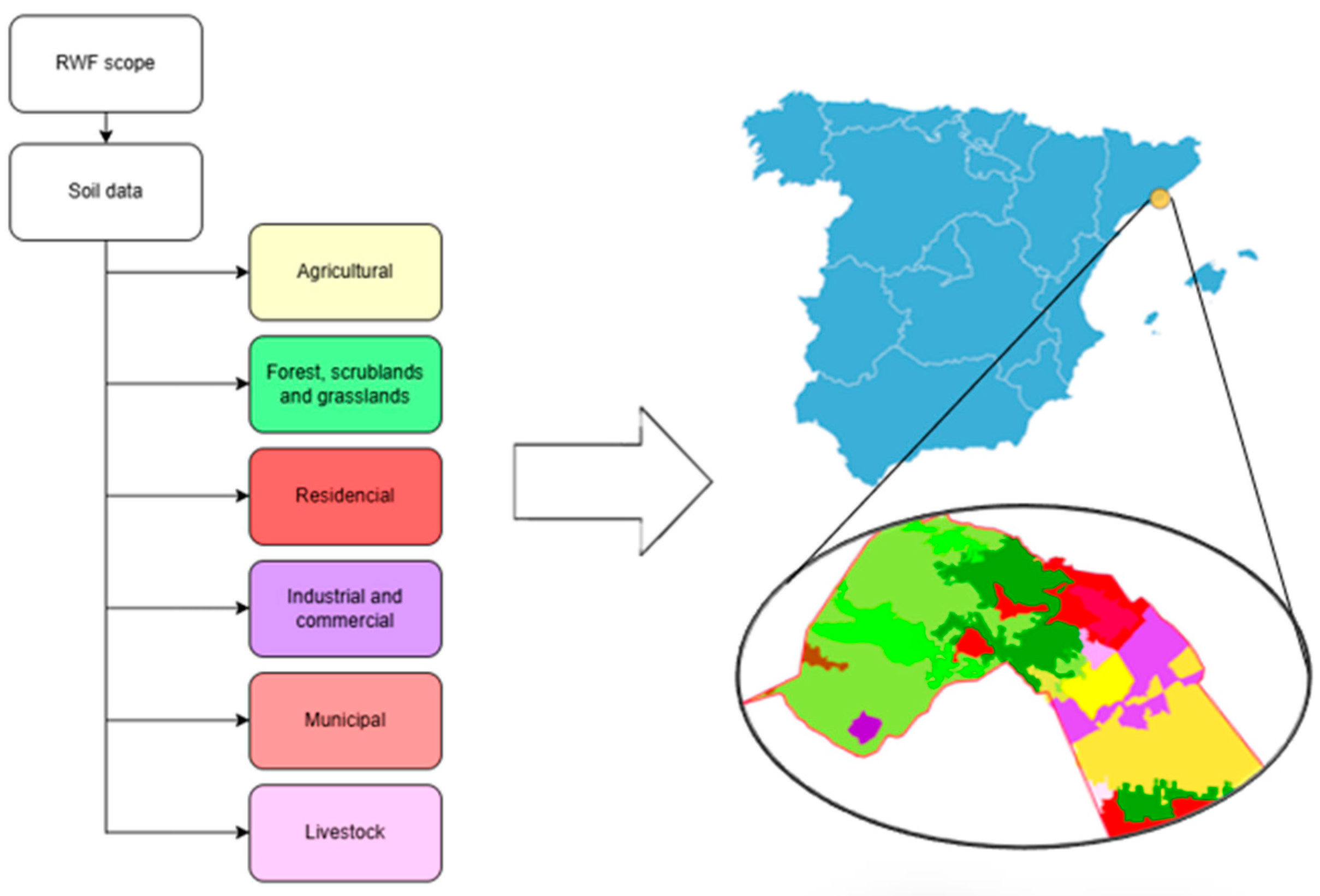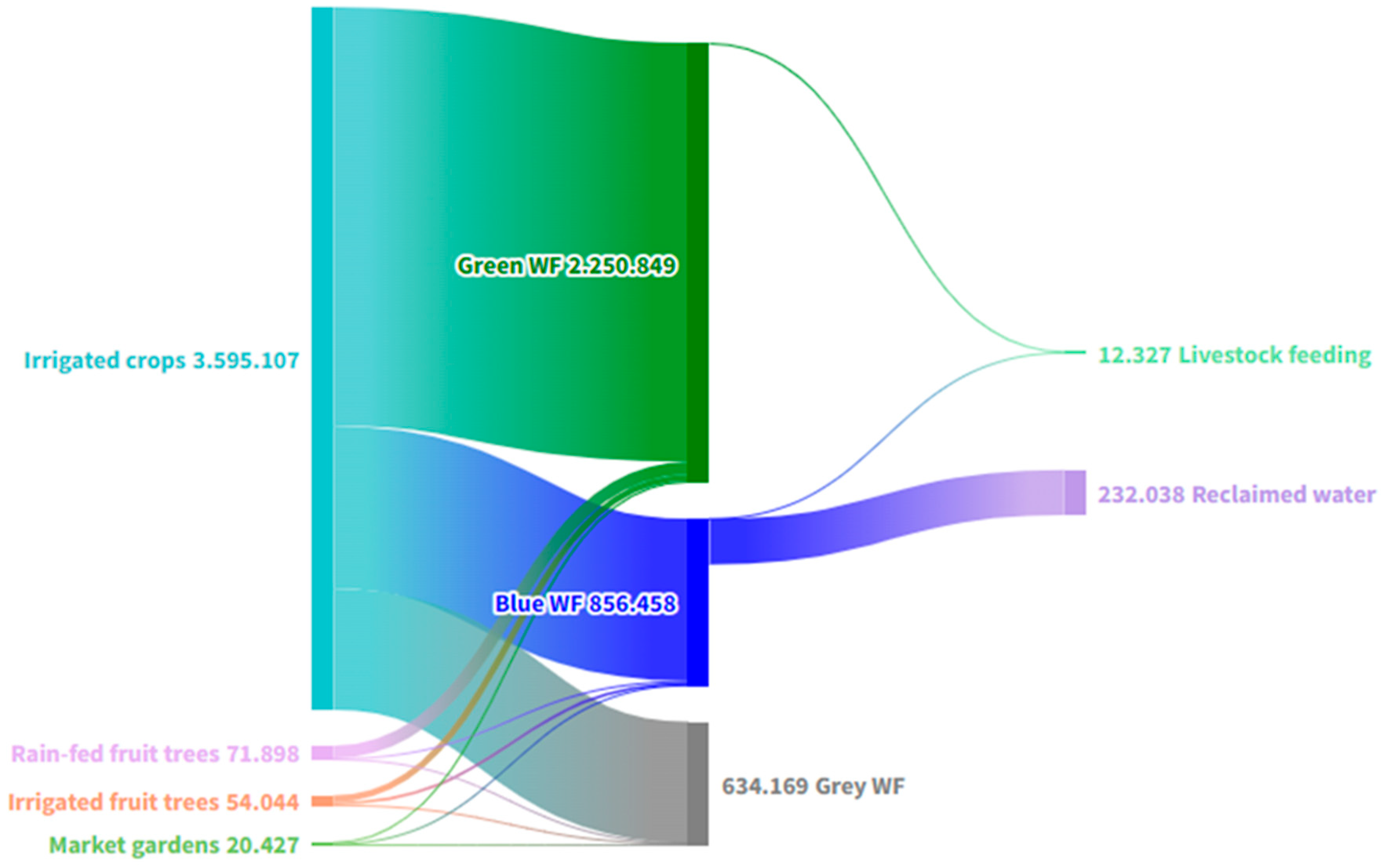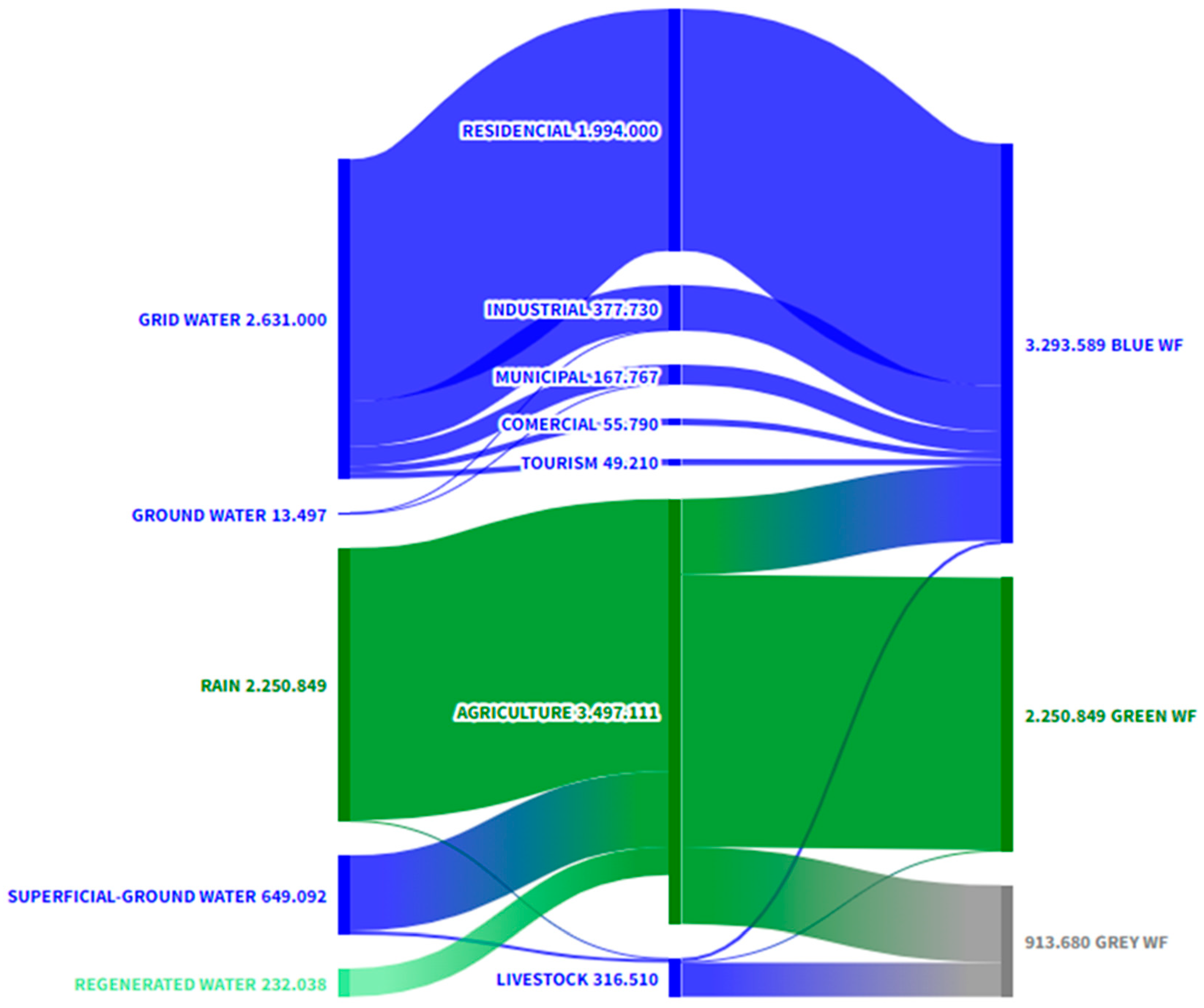Regional Water Footprint for a Medium-Size City in the Metropolitan Area of Barcelona: Gavà
Abstract
1. Introduction
2. Materials and Methods
2.1. Land Uses
2.2. Water Footprint Methodology per Economic Activity
2.2.1. Agricultural and Silviculture
2.2.2. Livestock
2.2.3. Municipal
2.2.4. Residential
2.2.5. Industrial
2.2.6. Commercial
2.2.7. Tourism
2.2.8. Wastewater Treatment (WWT)
2.2.9. Reclaimed Water
3. Results
3.1. Agriculture and Silviculture in Gavà
3.2. Livestock in Gavà
3.3. Municipal
3.4. Residential
3.5. Industrial
3.6. Commercial
Tourism
3.7. Wastewater Treatment Plants (WWTP)
3.8. Reclaimed Water
3.9. Gavà Regional WF
4. Discussion
5. Conclusions
Supplementary Materials
Author Contributions
Funding
Institutional Review Board Statement
Informed Consent Statement
Data Availability Statement
Acknowledgments
Conflicts of Interest
References
- IPCC. Climate Change 2021, The Physical Science Basis; Cambridge University Press: Cambridge, UK, 2021. [Google Scholar] [CrossRef]
- Dagan, G.; Stier, P. Constraint on precipitation response to climate change by combination of atmospheric energy and water budgets. NPJ Clim. Atmos. Sci. 2020, 3, 34. [Google Scholar] [CrossRef]
- Tramblay, Y.; Hertig, E. Modelling extreme dry spells in the Mediterranean region in connection with atmospheric circulation. Atmos. Res. 2018, 202, 40–48. [Google Scholar] [CrossRef]
- Zittis, G.; Bruggeman, A.; Lelieveld, J. Revisiting future extreme precipitation trends in the Mediterranean. Weather Clim. Extrem. 2021, 34, 100380. [Google Scholar] [CrossRef] [PubMed]
- IPCC. Impacts of 1.5 °C Global Warming on Natural and Human Systems. In Global Warming of 1.5 °C.; Cambridge University Press: Cambridge, UK, 2022; pp. 175–312. [Google Scholar] [CrossRef]
- Hoekstra, A.Y. Virtual Water Trade: Proceedings of the International Expert Meeting on Virtual Water Trade; IHE Delft: Delft, The Netherlands, 2003. [Google Scholar]
- Aldaya, M.M.; Chapagain, A.K.; Hoekstra, A.Y.; Mekonnen, M.M. The Water Footprint Assessment Manual: Setting the Global Standard; Routledge: London, UK, 2012. [Google Scholar]
- Mao, Y.; Liu, Y.; Zhuo, L.; Wang, W.; Li, M.; Feng, B.; Wu, P. Quantitative evaluation of spatial scale effects on regional water footprint in crop production. Resour. Conserv. Recycl. 2021, 173, 105709. [Google Scholar] [CrossRef]
- Vanham, D.; Bidoglio, G. The water footprint of Milan. Water Sci. Technol. 2013, 69, 789–795. [Google Scholar] [CrossRef] [PubMed]
- Zhang, S.; Taiebat, M.; Liu, Y.; Qu, S.; Liang, S.; Xu, M. Regional water footprints and interregional virtual water transfers in China. J. Clean. Prod. 2019, 228, 1401–1412. [Google Scholar] [CrossRef]
- Li, M.; Zhuo, L.; Wu, P. Non-negligible regional differences in the driving forces of crop-related water footprint and virtual water flows: A case study for the Beijing-Tianjin-Hebei region. In Proceedings of the EGU General Assembly Conference Abstracts 2020, Online, 4–8 May 2020. [Google Scholar] [CrossRef]
- Aldaya, M.M.; Rodriguez, C.I.; Fernandez-Poulussen, A.; Merchan, D.; Beriain, M.J.; Llamas, R. Grey water footprint as an indicator for diffuse nitrogen pollution: The case of Navarra, Spain. Sci. Total Environ. 2020, 698, 134338. [Google Scholar] [CrossRef] [PubMed]
- Kong, Y.; He, W.; Zhang, Z.; Shen, J.; Yuan, L.; Gao, X.; An, M.; Ramsey, T.S. Spatial-temporal variation and driving factors decomposition of agricultural grey water footprint in China. J. Environ. Manag. 2022, 318, 115601. [Google Scholar] [CrossRef] [PubMed]
- INE. Cifras oficiales de población de los municipios españoles en aplicación de la Ley de Bases del Régimen Local (Art. 17). Instituto Nacional de Estadística (INE) 2022. Available online: https://www.ine.es/jaxiT3/Datos.htm?t=2861 (accessed on 13 January 2024).
- Yalcinkaya, S. Spatiotemporal analysis and mitigation potential of GHG emissions from the livestock sector in Turkey. Environ. Impact Assess. Rev. 2024, 105, 107441. [Google Scholar] [CrossRef]
- Hoekstra, A.Y.; Mekonnen, M.M. The water footprint of humanity. Proc. Natl. Acad. Sci. USA 2012, 109, 3232–3237. [Google Scholar] [CrossRef] [PubMed]
- Brauman, K.A.; Siebert, S.; Foley, J.A. Improvements in crop water productivity increase water sustainability and food security—A global analysis. Environ. Res. Lett. 2013, 8, 024030. [Google Scholar] [CrossRef]
- Allen, R.G.; Pereira, L.S.; Raes, D.; Smith, M. Crop evapotranspiration: Guidelines for computing crop water requirements. Fao Rome 1998, 300, D05109. [Google Scholar]
- FAO. Cropwat 8.0; FAO: Rome, Italy, 2010. [Google Scholar]
- Mekonnen, M.M.; Hoekstra, A.Y. The green, blue and grey water footprint of crops and derived crop products. Hydrol. Earth Syst. Sci. 2011, 15, 1577–1600. [Google Scholar] [CrossRef]
- Mekonnen, M.M. The Green, Blue and Grey Water Footprint of Farm Animals and Animal Products; Appendix III; Department of Water Engineering and Management, University of Twente: Enschede, The Netherlands, 2010. [Google Scholar]
- Ajuntament de Gavà. Viabilitat del Subministrament D’hortalissa i Fruita del PABLL a les Escoles de Gavà; Ajuntament de Gavà: Barcelona, Spain, 2022. [Google Scholar]
- Superficies y Producciones Anuales de Cultivos; Ministerio de Agricultura, Pesca y Alimentación: Madrid, Spain, 2022.
- Mekonnen, M.M. The Green, Blue and Grey Water Footprint of Farm Animals and Animal Products; Appendix IV; Department of Water Engineering and Management, University of Twente: Enschede, The Netherlands, 2010. [Google Scholar]
- Chapagain, A.K.; Hoekstra, A.Y.; Hoekstra, A.I. Virtual Water Flows Between Nations in Relation to Trade in Livestock and Livestock Products; UNESCO-IHE: Delft, The Netherlands, 2003. [Google Scholar]
- Mekonnen, M.M.; Hoekstra, A.Y. A global assessment of the water footprint of farm animal products. Ecosystems 2012, 15, 401–415. [Google Scholar] [CrossRef]
- Nations, F.A.O. Egg Marketing: A Guide for the Production and Sale of Eggs; Food & Agriculture Organization: Rome, Italy, 2003. [Google Scholar]
- Schubert, H.; Wood, S.; Reyher, K.; Mills, H. Data-driven approach to using individual cattle weights to estimate mean adult dairy cattle weight. Vet. Rec. 2019, 185, 540. [Google Scholar] [CrossRef] [PubMed]
- Mekonnen, M.M. The Green, Blue and Grey Water Footprint of Farm Animals and Animal Products; Appendix V; Department of Water Engineering and Management, University of Twente: Enschede, The Netherlands, 2010. [Google Scholar]
- Orden ARM/2656/2008; Normativa sobre Calidad de las Aguas en España: Madrid, Spain, 2008.
- Lv, J.; Liu, Y.; Feng, J.; Liu, Q.; Nan, F.; Xie, S. Nutrients removal from undiluted cattle farm wastewater by the two-stage process of microalgae-based wastewater treatment. Bioresour. Technol. 2018, 264, 311–318. [Google Scholar] [CrossRef]
- Hena, S.; Fatimah, S.; Tabassum, S. Cultivation of algae consortium in a dairy farm wastewater for biodiesel production. Water Resour. Ind. 2015, 10, 1–14. [Google Scholar] [CrossRef]
- Zheng, T.; Li, P.; Ma, X.; Sun, X.; Wu, C.; Wang, Q.; Gao, M. Pilot-scale experiments on multilevel contact oxidation treatment of poultry farm wastewater using saran lock carriers under different operation model. J. Environ. Sci. 2019, 77, 336–345. [Google Scholar] [CrossRef] [PubMed]
- Zhang, R.; Wang, L.; Hussain Lakho, F.; Yang, X.; Depuydt, V.; Igodt, W.; Quan Le, H.; Rousseau, D.P.L.; Van Hulle, S. Iron oxide coated sand (IOS): Scale-up analysis and full-scale application for phosphorus removal from goat farm wastewater. Sep. Purif. Technol. 2022, 284, 120213. [Google Scholar] [CrossRef]
- Conservation, G.F.A. Biodiversity and Tourism: Conflicts on the World’s Seacoasts and Strategies for Their Solution; Springer Science & Business Media: Berlin, Germany, 2012. [Google Scholar]
- Rico-Amorós, A.M.; Olcina-Cantos, J.; Sauri, D. Tourist land use patterns and water demand: Evidence from the Western Mediterranean. Land Use Policy 2009, 26, 493–501. [Google Scholar] [CrossRef]
- Eurostat. MEDSTAT II: “Water and Tourism” Pilot Study; European Commission: Brussel, Belgium, 2009.
- INE. Establecimientos, plazas estimadas, grados de ocupación y personal empleado por zonas turísticas. Instituto Nacional de Estadística (INE) 2023. Available online: https://www.ine.es/jaxiT3/Tabla.htm?t=2013&L=0 (accessed on 21 March 2024).
- Somoza-Tornos, A.; Rives-Jiménez, M.; Espuña, A.; Graells, M. A circular economy approach to the design of a water network targeting the use of regenerated water. Comput. Aided Chem. Eng. 2019, 47, 119–124. [Google Scholar] [CrossRef]
- MAPAMA. Mapa de Cultivos y Aprovechamientos de España 1:50.000 del Año 2000–2010. 2017. Available online: https://www.mapama.gob.es/ide/metadatos/srv/spa/catalog.search#/metadata/d50803e5-e53b-4c55-b643-dcc964c5f677 (accessed on 22 February 2024).
- Idecat. Nombre de caps per espècies. Institut d’Estadística de Catalunya 2022. Available online: https://www.idescat.cat/pub/?id=censag&n=5107&lang=es&by=mun (accessed on 12 November 2023).
- Tokhun, N.; Iwai, C.B.; Ta-Oun, M. Piggery Farm Wastewater: Alternative Solution for Agriculture and Soil Fertility. Int. J. Environ. Rural. Dev. 2010, 1, 58–61. [Google Scholar] [CrossRef]
- Huang, W.; Shuai, C.; Xiang, P.; Chen, X.; Zhao, B. Mapping water scarcity risk in China with the consideration of spatially heterogeneous environmental flow requirement. Environ. Impact Assess. Rev. 2024, 105, 107400. [Google Scholar] [CrossRef]




| Animal | Average Life Time (year) | Average Animal Weight at End of Lifetime (kg) | WF in Grazing Systems (m3/Animal in the Facility·Year) | WF in Mixed Systems (m3/Animal in the Facility·Year) | WF in Industrial Systems (m3/Animal in the Facility·Year) |
|---|---|---|---|---|---|
| Beef cattle | 3 | 253 | 767.08 | 712.16 | 474.83 |
| Dairy cattle | 10 | 617 | 1368.65 | 1270.66 | 847.20 |
| Broiler chicken | 0.25 | 1.90 | 27.24 | 16.23 | 27.53 |
| Layer chicken | 1.4 | 1.5 | 21.50 | 12.81 | 21.73 |
| Pig | 0.75 | 102 | 1109.95 | 1069.56 | 729.31 |
| Sheep | 2.1 | 31.3 | - | 71.41 | - |
| Goat | 2.3 | 24.6 | - | 38.85 | - |
| Horse | 12 | 473 | - | - | 1479.94 |
| Animal | Grazing | Mixed | Industrial | |||||||||
|---|---|---|---|---|---|---|---|---|---|---|---|---|
| Green WF | Blue WF | Grey WF | Total WF | Green WF | Blue WF | Grey WF | Total WF | Green WF | Blue WF | Grey WF | Total WF | |
| Beef cattle | 696.56 | 32.44 | 38.08 | 767.08 | 636.26 | 34.63 | 41.27 | 712.16 | 379.25 | 43.71 | 51.87 | 474.83 |
| Dairy cattle | 1242.83 | 57.88 | 67.94 | 1368.65 | 1135.24 | 61.79 | 73.63 | 1270.66 | 676.67 | 77.99 | 92.54 | 847.20 |
| Broiler chicken | 21.20 | 2.54 | 3.50 | 27.24 | 12.62 | 1.53 | 2.08 | 16.23 | 21.44 | 2.56 | 3.53 | 27.53 |
| Layer chicken | 16.74 | 2.00 | 2.76 | 21.50 | 9.96 | 1.21 | 1.64 | 12.81 | 16.92 | 2.02 | 2.79 | 21.73 |
| Pig | 869.54 | 116.62 | 123.79 | 1109.95 | 833.70 | 114.28 | 121.58 | 1069.56 | 562.77 | 84.27 | 82.27 | 729.31 |
| Sheep | - | - | - | - | 67.06 | 4.33 | 0.02 | 71.41 | - | - | - | - |
| Goat | - | - | - | - | 35.60 | 3.25 | 0.00 | 38.85 | - | - | - | - |
| Horse | - | - | - | - | - | - | - | - | 1090.40 | 291.23 | 98.31 | 1479.94 |
| Animal | % of Concentrate Feed in Grazing Systems | % of Concentrate Feed in Mixed Systems | % of Concentrate Feed in Industrial Systems |
|---|---|---|---|
| Beef cattle | 0.90 | 2.00 | 20.40 |
| Dairy cattle | 14.80 | 41.70 | 92.90 |
| Broiler chicken | 37.20 | 48.50 | 90.90 |
| Layer chicken | 33.30 | 44.40 | 89.70 |
| Pig | 32.70 | 78.70 | 99.70 |
| Sheep | 0 | 0.40 | - |
| Goat | - | - | - |
| Horse * | 0.90 | 2.00 | 20.40 |
| Animal | Green RWF (m3) | Blue RWF (m3) | Grey RWF (m3) | Total RWF (m3) | RWF Per Animal/Year (m3) |
|---|---|---|---|---|---|
| Pig | 1874 | 24,919 | 276,227 | 303,019 | 273.01 |
| Horse | 8028 | 2179 | 3284 | 13,492 | 1499.06 |
Disclaimer/Publisher’s Note: The statements, opinions and data contained in all publications are solely those of the individual author(s) and contributor(s) and not of MDPI and/or the editor(s). MDPI and/or the editor(s) disclaim responsibility for any injury to people or property resulting from any ideas, methods, instructions or products referred to in the content. |
© 2025 by the authors. Licensee MDPI, Basel, Switzerland. This article is an open access article distributed under the terms and conditions of the Creative Commons Attribution (CC BY) license (https://creativecommons.org/licenses/by/4.0/).
Share and Cite
Ferreiro-Crespo, I.; Villanueva-Rey, P.; Ruiz, M.; Lorenzo-Toja, Y.; Feijoo, G. Regional Water Footprint for a Medium-Size City in the Metropolitan Area of Barcelona: Gavà. Sustainability 2025, 17, 2302. https://doi.org/10.3390/su17052302
Ferreiro-Crespo I, Villanueva-Rey P, Ruiz M, Lorenzo-Toja Y, Feijoo G. Regional Water Footprint for a Medium-Size City in the Metropolitan Area of Barcelona: Gavà. Sustainability. 2025; 17(5):2302. https://doi.org/10.3390/su17052302
Chicago/Turabian StyleFerreiro-Crespo, Iago, Pedro Villanueva-Rey, Mario Ruiz, Yago Lorenzo-Toja, and Gumersindo Feijoo. 2025. "Regional Water Footprint for a Medium-Size City in the Metropolitan Area of Barcelona: Gavà" Sustainability 17, no. 5: 2302. https://doi.org/10.3390/su17052302
APA StyleFerreiro-Crespo, I., Villanueva-Rey, P., Ruiz, M., Lorenzo-Toja, Y., & Feijoo, G. (2025). Regional Water Footprint for a Medium-Size City in the Metropolitan Area of Barcelona: Gavà. Sustainability, 17(5), 2302. https://doi.org/10.3390/su17052302








